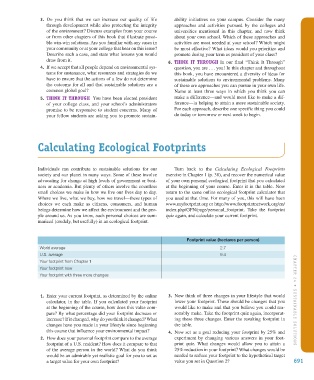Page 692 - Environment: The Science Behind the Stories
P. 692
3. Do you think that we can increase our quality of life ability initiatives on your campus. Consider the many
through development while also protecting the integrity approaches and activities pursued by the colleges and
of the environment? Discuss examples from your course universities mentioned in this chapter, and now think
or from other chapters of this book that illustrate possi- about your own school. Which of these approaches and
ble win-win solutions. Are you familiar with any cases in activities are most needed at your school? Which might
your community or at your college that bear on this issue? be most effective? What ideas would you prioritize and
Describe such a case, and state what lessons you would promote during your term as president of your class?
draw from it. 6. tHINK It tHroUGH In our final “Think It Through”
4. If we accept that all people depend on environmental sys- question, you are . . . you! In this chapter and throughout
tems for sustenance, what resources and strategies do we this book, you have encountered a diversity of ideas for
have to ensure that the actions of a few do not determine sustainable solutions to environmental problems. Many
the outcome for all and that sustainable solutions are a of these are approaches you can pursue in your own life.
common global goal? Name at least three ways in which you think you can
5. tHINK It tHroUGH You have been elected president make a difference—and would most like to make a dif-
of your college class, and your school’s administrators ference—in helping to attain a more sustainable society.
promise to be responsive to student concerns. Many of For each approach, describe one specific thing you could
your fellow students are asking you to promote sustain- do today or tomorrow or next week to begin.
Calculating ecological Footprints
Individuals can contribute to sustainable solutions for our Turn back to the Calculating Ecological Footprints
society and our planet in many ways. Some of these involve exercise in Chapter 1 (p. 38), and recover the numerical value
advocating for change at high levels of government or busi- of your own personal ecological footprint that you calculated
ness or academia. But plenty of others involve the countless at the beginning of your course. Enter it in the table. Now
small choices we make in how we live our lives day to day. return to the same online ecological footprint calculator that
Where we live, what we buy, how we travel—these types of you used at that time. For many of you, this will have been
choices we each make as citizens, consumers, and human www.myfootprint.org or http://www.footprintnetwork.org/en/
beings determine how we affect the environment and the peo- index.php/GFN/page/personal_footprint. Take the footprint
ple around us. As you know, such personal choices are sum- quiz again, and calculate your current footprint.
marized (crudely, but usefully) in an ecological footprint.
Footprint value (hectares per person)
World average 2.7
U.S. average 9.4
Your footprint from Chapter 1
Your footprint now
Your footprint with three more changes
1. Enter your current footprint, as determined by the online 3. Now think of three changes in your lifestyle that would
calculator, in the table. If you calculated your footprint lower your footprint. These should be changes that you CHAPTER 24 • Su STA in A bl E Sol u T i on S
at the beginning of the course, how does this value com- would like to make and that you believe you could rea-
pare? By what percentage did your footprint decrease or sonably make. Take the footprint quiz again, incorporat-
increase? If it changed, why do you think it changed? What ing these three changes. Enter the resulting footprint in
changes have you made in your lifestyle since beginning the table.
this course that influence your environmental impact? 4. Now set as a goal reducing your footprint by 25% and
2. How does your personal footprint compare to the average experiment by changing various answers in your foot-
footprint of a U.S. resident? How does it compare to that print quiz. What changes would allow you to attain a
of the average person in the world? What do you think 25% reduction in your footprint? What changes would be
would be an admirable yet realistic goal for you to set as needed to reduce your footprint to the hypothetical target
a target value for your own footprint? value you set in Question 2? 691
M24_WITH7428_05_SE_C24.indd 691 13/12/14 10:40 AM

